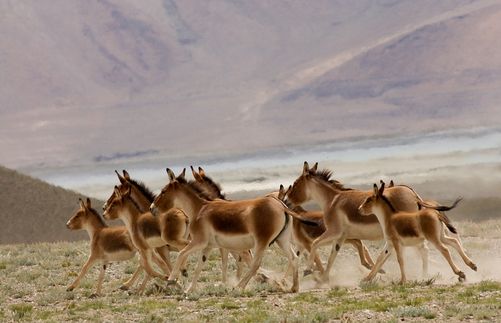Equus kiang
IUCN
LCBasic Information
Scientific classification
- name:Equus kiang
- Scientific Name:Tibetan donkey, wild horse
- Outline:Ungulata
- Family:Perissodactyla Equidae Equus
Vital signs
- length:2m
- Weight:300-400kg
- lifetime:25-30 year
Feature
Like to race with cars
Distribution and Habitat
Native to the Qinghai-Tibet Plateau, distributed in China, India, Nepal and Pakistan; uncertainty exists: Bhutan.
Mainly distributed in Yushu, Guoluo, Haibei and Haixi Prefectures in Qinghai, China, Aksai, Sunan, Nanbei and Maqu in Gansu, Altun Mountains in Xinjiang, western Nagqu Prefecture in Tibet, northwest of Ali Prefecture and Shigatse Prefecture, Sichuan.
Appearance
Male Tibetan wild donkeys are larger. Their limbs are thicker, and they are more vigorous than domestic donkeys. They have short and wide heads, slightly rounded and blunt muzzles, and ears that are more than 170 mm long. Their manes are short and straight, and their tail manes grow in the back half of the tail or 1/3 of the tail end. Their limbs are thick, and there are round corpora callosum on the inner side of their forelimbs, commonly known as "night eyes". Their hooves are narrow and high. Their muzzles are milky white, their backs are brown or dark brown (the summer hair is slightly black), their flanks are darker, to dark brown, and they have obvious narrow tan or black-brown ridges from the rear end of the shoulder mane along the spine to the tail, commonly known as "back velvet". There is an obvious brown stripe on the outside of each shoulder blade, and a typical white wedge-shaped spot on the back side of the shoulder. The anterior ventral angle of this
Details
The Tibetan wild donkey is a unique animal on the Qinghai-Tibet Plateau. It is the only wild donkey species in the world and a national first-class protected animal.

If you drive into Tibet or go to Xinjiang, Gansu, Qinghai and other high-altitude mountainous areas where Tibetan wild donkeys are active, wild donkeys in the distance will curiously watch the cars approaching them. When the car is close to them, the wild donkeys will run forward and try to keep parallel with the car. Sometimes the driver also intends to compete with the wild donkeys and drives the car to 60 kilometers per hour to compete with the wild donkeys. The wild donkeys will always run in front of the car and pass in front of the car before they are willing to give up. After the wild donkeys pass the car, they often continue to run for a while, and then stop to watch. Sometimes wild donkeys pay the price of their lives for this strange behavior. Some poachers drive cars to chase wild donkeys. There was once a car and 4 wild donkeys running side by side in the desert at an altitude of 4,000 meters for more than ten kilometers, and the speed of the wild donkeys did not slow down at all. Although the Tibetan wild donkeys have excellent endurance and can run 40-50 kilometers in one breath without rest, using cars to chase wild animals for a long time may have adverse consequences for them. When encountering this kind of "race", people will take the initiative to slow down and let the wild donkeys run in front of the car.
Tibetan wild donkeys are extremely drought-resistant and can go without water for several days. Their hearing, smell and vision are very sensitive and they can detect situations hundreds of meters away from them. If they find someone approaching or an enemy attacking, they will first look up quietly, stare for a moment, and then run away. After running a distance, they feel safe, stop and stand to watch, and then run again. They always run, stop, look, and then run again. They like to live in groups, are good at running, and are highly vigilant.
The main natural enemies of Tibetan wild donkeys include gray wolves, snow leopards and lynxes. Due to proper protection measures, the population of Tibetan wild donkeys has increased year by year, and there are nearly 60,000 in Qiangtang alone. According to estimates by Liu Wulin and others, the number of Tibetan wild donkeys was about 56,000 in 1989, and the total number in 1998 was close to 80,000. In addition, according to surveys and statistics by the World Wildlife Fund, there are large groups of wild donkeys in the northern part of Chabu Township, Gaize County, Ali, and in some parts of the northwest of Nima County, with some groups of more than 500. Therefore, the number of Tibetan wild donkeys far exceeds this number and has reached 100,000.
In the past, Tibetan wild donkeys lived in remote and sparsely populated areas of the Qinghai-Tibet Plateau and were protected by nature. However, in recent years, due to extreme food shortages in some areas caused by human overgrazing, or due to interference from human activities such as gold panning, illegal poaching has also occurred from time to time, and the population of Tibetan wild donkeys has been declining. In order to protect this species, the Chinese government has listed the Tibetan wild donkey as a first-class key protected animal, and hunting is strictly prohibited.
In November 2021, herders at the source of the Yellow River photographed a large population of Tibetan wild donkeys at close range for the first time, with an estimated number of 500 Tibetan wild donkeys.
Listed in the IUCN Red List of Threatened Species in 2015 ver3.1-Least Concern (LC).
Listed in Appendix I, II and III of the Convention on International Trade in Endangered Species of Wild Fauna and Flora (CITES) 2019 Edition Appendix II.
Listed in China's "National Key Protected Wildlife List" (February 5, 2021) Level 1.
Protect wildlife and eliminate game.
Maintaining ecological balance is everyone's responsibility!








